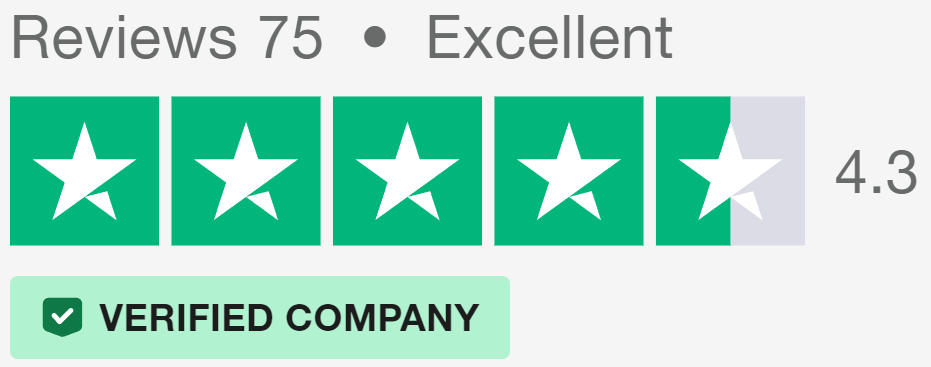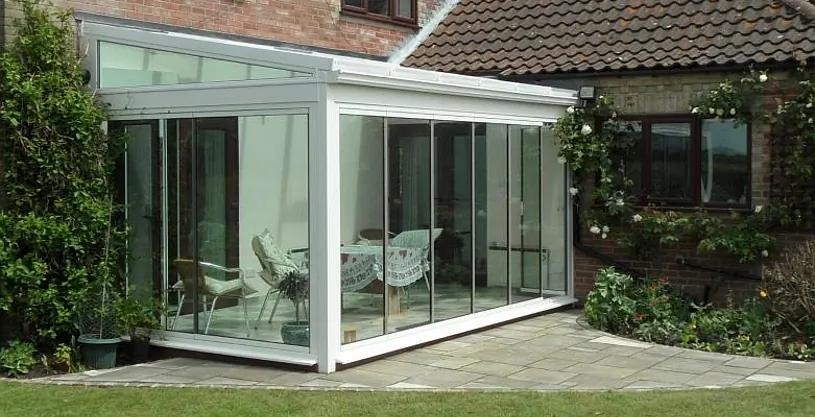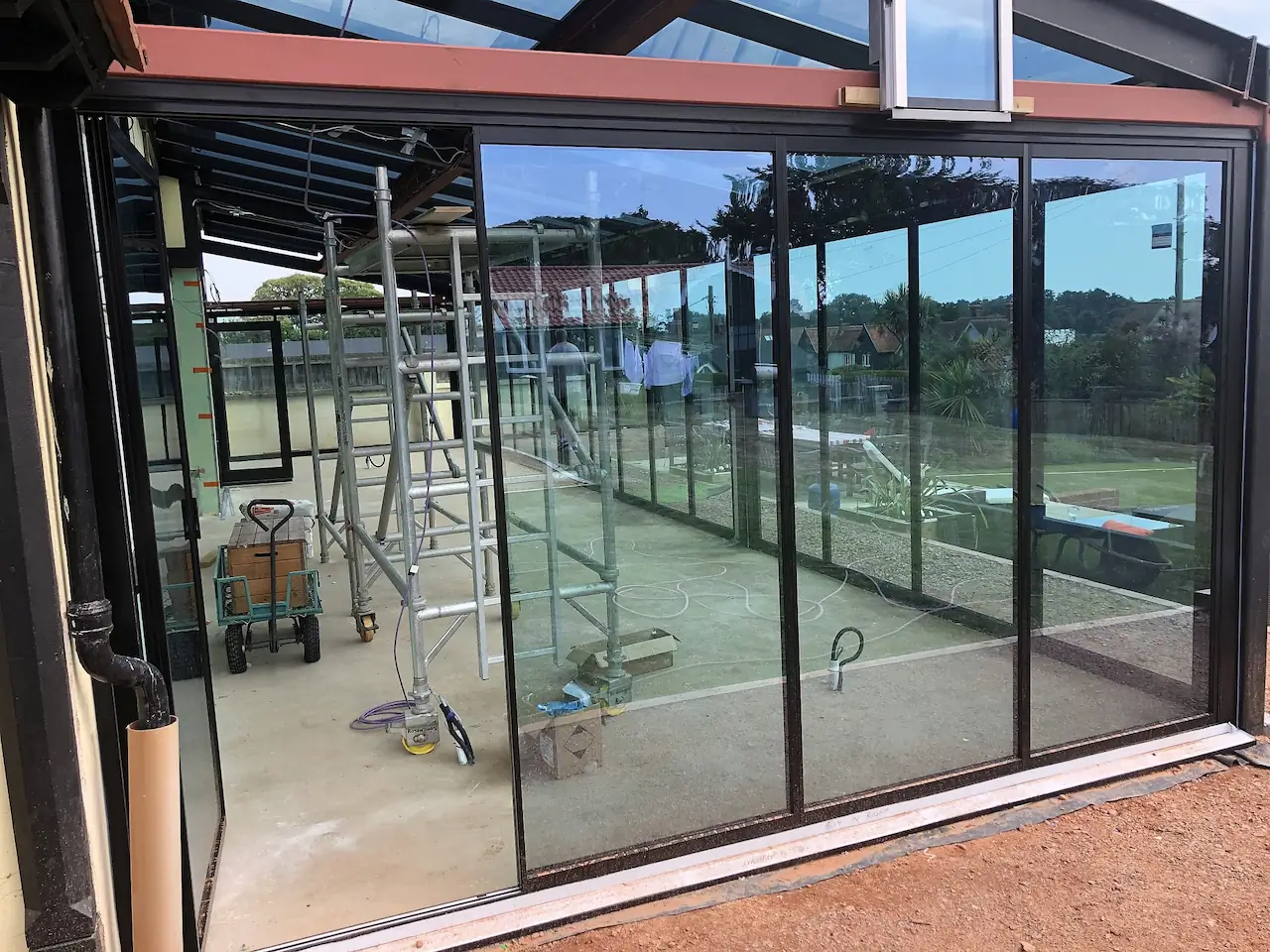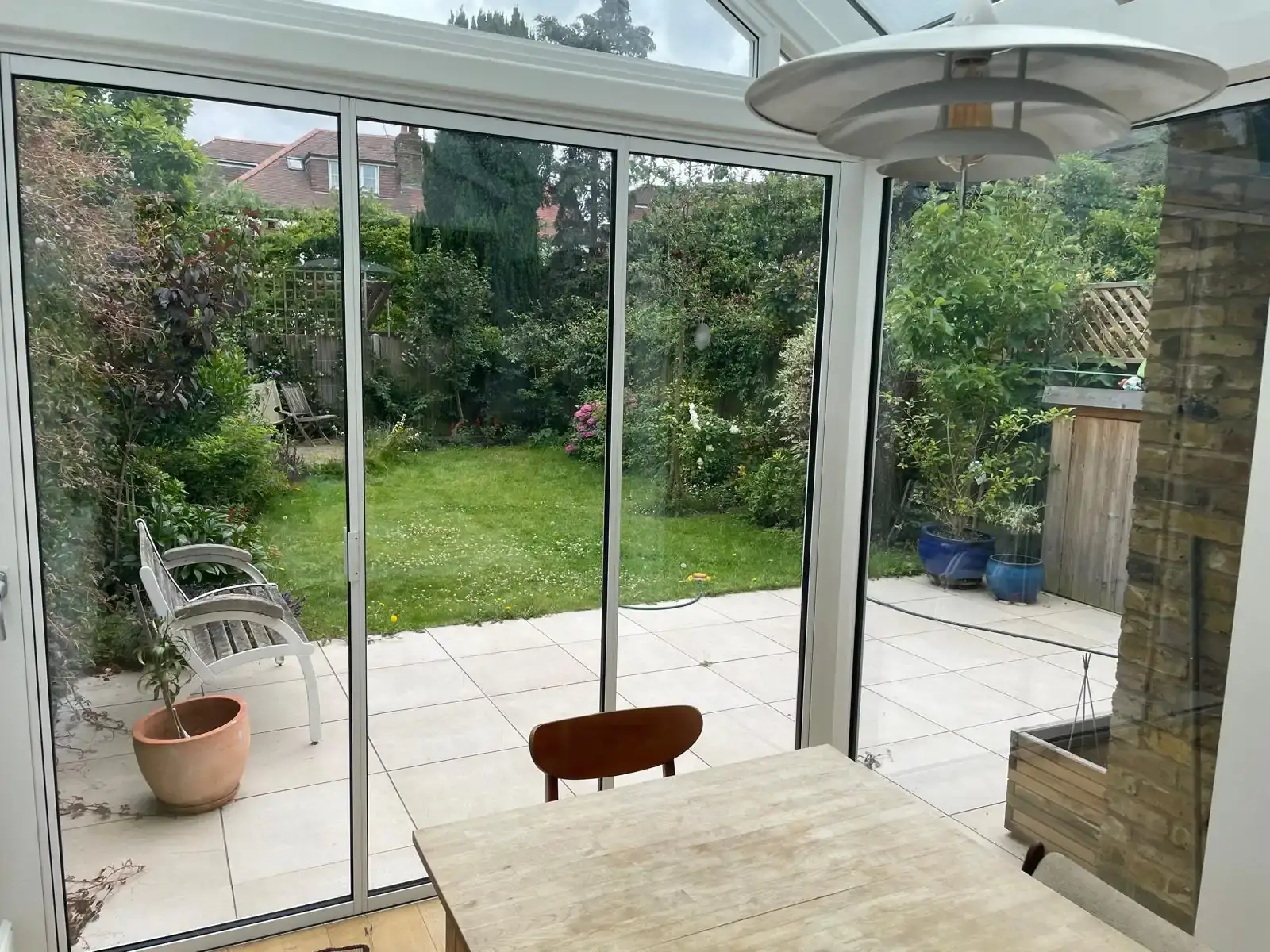Sliding Conservatory Doors: Complete Buyer’s Guide
Table of Contents

Benefits of Sliding Conservatory Doors

How Sliding Mechanisms Work
The magic of sliding conservatory doors lies in their simple yet effective mechanism. Unlike traditional hinged doors, these glide along tracks, typically fitted at the top and bottom of the frame. This design allows for effortless operation, even with large glass panels.
Rollers or wheels attached to the door frame enable smooth movement along the tracks. High-quality sliding systems often use stainless steel or nylon rollers for durability and quiet operation. The weight of the door is evenly distributed, making it easy to open and close regardless of size.
For larger openings, multi-panel sliding conservatory doors can be installed. These systems allow multiple panels to slide independently, stacking neatly to one side. This flexibility lets you adjust the opening size to suit your needs, from a small gap for ventilation to a wide entrance for summer gatherings.
The Impact of Large Glass Panels
One of the standout features of sliding conservatory doors is their expansive glass panels. These large glazed areas flood your conservatory with natural light, creating a bright and inviting atmosphere. On gloomy British days, this extra light can make a world of difference to your mood and the feel of your space.
In a conservatory with sliding doors, you can enjoy your garden views year-round, regardless of the weather. In summer, open the doors wide to let in fresh air and extend your living space. During colder months, keep them closed while still enjoying the outdoor scenery from the comfort of your warm conservatory.
While the glass takes centre stage, the frames of sliding conservatory doors play a role too. Slim frame profiles maximise the glass area, further improving your view and light intake. Modern frame materials like aluminium allow for narrower profiles without compromising on strength or insulation.
The visual impact of sliding conservatory doors goes beyond just the view they provide. When closed, their sleek lines and large glass panels create a contemporary look that can refresh the appearance of your entire conservatory. Open, they create a striking architectural feature, framing your garden like a living picture.
Types of Sliding Conservatory Doors
Internal Sliding Doors
Sliding interior doors offer a flexible way to divide your conservatory from the main living area. These doors allow you to create separate zones within your home while maintaining an open feel. On cooler days, close the sliding conservatory doors to keep the heat in your main living space. When the weather warms up, slide them open to create a larger, combined area.
The beauty of internal conservatory doors lies in their adaptability. They let you adjust your living space to suit different occasions. Hosting a dinner party? Keep the doors closed for a more intimate dining experience. Having a summer barbecue? Slide them open to create a flowing space from your kitchen to the conservatory and out to the garden.
External Sliding Doors
External sliding doors (also known as patio sliding doors or simply patio doors) serve as the main entry point to your garden or patio. These doors typically span the width of your conservatory, offering expansive views and easy access to your garden. Large glass panels in external sliding conservatory doors flood your space with natural light, creating a bright and airy atmosphere even on overcast days.

Slide and Fold Doors
Slide and fold doors, also known as slide and stack or slide and swing doors, offer the ultimate in flexibility for your conservatory. These doors combine the smooth operation of sliding doors with the wide opening capabilities of bifold doors. Each panel can slide along a track and then pivot to stack neatly against the wall. The frames are often thinner than bi-fold doors too, since there is no need for a complicated hinge mechanism.
This design allows you to open up almost the entire width of your conservatory. Slide and fold conservatory doors are particularly useful for larger openings where standard sliding doors might be impractical.
The ability to partially or fully open slide and fold doors gives you precise control over ventilation and access. On mild days, open just one or two panels for a gentle breeze. For garden parties or when you simply want to bask in the summer sun, fold all the panels back and enjoy an unobstructed opening.
Glass Options for Sliding Conservatory Doors
Double Glazing
Double glazing is the standard choice for sliding conservatory doors in the UK. It consists of two panes of glass separated by a gap filled with air or an inert gas like argon. This construction improves insulation, helping to keep your conservatory warm in winter and cool in summer.
The insulating properties of double-glazed sliding conservatory doors can lead to noticeable energy savings. By reducing heat loss in colder months, they can help lower your heating bills. In summer, they help prevent your conservatory from overheating, potentially reducing the need for air conditioning or fans.
Noise reduction is another advantage of double glazing in conservatory sliding doors. The two panes of glass, separated by the insulating gap, create a barrier that dampens outside noise. This can be particularly beneficial if your conservatory overlooks a busy street or if you live in a noisy area.
Tinted and Low-E Glass
Tinted glass for sliding conservatory doors can help manage light and heat in your space. A slight tint reduces glare without having a big impact on the amount of natural light entering your conservatory. This can be particularly useful if your conservatory faces south and receives strong sunlight throughout the day.
Low-E (low emissivity) glass takes heat management a step further. This special coating on the glass reflects heat back into your conservatory in winter while reflecting the sun’s heat away in summer. Conservatory doors with Low-E glass can help maintain a more stable temperature year-round, improving comfort and potentially reducing energy costs.
Some manufacturers offer sliding doors for conservatories with both tinted and Low-E properties. This combination provides excellent control over light and heat, helping to create a comfortable conservatory environment in all seasons.
When selecting glass for your conservatory internal doors, consider how you use the space throughout the year. If you often use your conservatory as a dining area, for example, you might prefer clear glass to maintain bright, natural light. For a space used as a home office or TV room, tinted glass could help reduce screen glare.
Remember that the effectiveness of any glass type in sliding conservatory doors depends on the overall design and construction of your conservatory. Factors like roof material, ventilation, and the direction your conservatory faces all play a part in its thermal performance.
Frame Materials and Colours

Aluminium and uPVC Frames
Aluminium frames are a popular choice for sliding conservatory doors due to their strength and slim profile. This material allows for larger glass panels and narrower frames, which can increase the amount of light entering your conservatory. Aluminium is also highly durable and resistant to corrosion, making it a long-lasting option for British weather conditions.
uPVC (unplasticised polyvinyl chloride) is another common material for conservatory sliding doors. It’s known for its excellent insulation properties and low maintenance requirements. uPVC frames are typically cheaper than aluminium, making them a budget-friendly option. They’re also available in a wide range of colours and finishes, allowing you to match your conservatory doors to your home’s style.
Both aluminium and uPVC frames for sliding conservatory doors offer good thermal performance, helping to keep your conservatory comfortable year-round. The choice between the two often comes down to personal preference, budget, and the specific requirements of your conservatory design.
Frame Colour Options
The colour of your sliding conservatory doors can have a big impact on the overall look of your space. White remains a classic choice, offering a clean, bright appearance that complements most conservatory styles. It’s particularly popular for traditional conservatories and can help make the space feel larger and airier.
For a more modern look, many homeowners are opting for darker frame colours on their conservatory doors with sliding panels. Black, anthracite grey, and dark green can create a striking contrast with the glass and surrounding architecture. These darker colours can also help frame the view of your garden, drawing the eye outward.
Wood-effect finishes are available for both aluminium and uPVC sliding conservatory doors. These options provide the warm, natural look of timber without the high maintenance requirements. From light oak to rich mahogany, wood-effect finishes can help your conservatory doors blend with traditional home styles or create a cosy, rustic feel.
Integral Blinds
Some sliding conservatory doors come with the option of integral blinds. These are blinds fitted between the panes of glass in double-glazed units. They offer a sleek, modern solution for privacy and light control in your conservatory.
Integral blinds in conservatory sliding doors are protected from dust and damage, making them a low-maintenance option. They’re operated either magnetically or electronically, allowing you to adjust them easily. This feature can be particularly useful in a conservatory, where changing light conditions throughout the day might require frequent adjustment of blinds.
The convenience of integral blinds in sliding doors for conservatories extends to cleaning as well. With no exposed slats to collect dust, keeping your conservatory looking tidy becomes much easier. This can be especially beneficial in a garden-facing conservatory where pollen and outdoor debris might otherwise collect on traditional blinds.
Key Factors for Buyers
Accurate Measurements
Precise measurements are vital when fitting sliding conservatory doors. Even small errors can lead to gaps, affecting insulation and security. It’s best to have a professional measure your opening to ensure a perfect fit. They’ll account for factors like the threshold height and frame size, which can vary depending on the door system you choose.
For those dreaming of a conservatory with sliding doors that span from floor to ceiling, extra care in measurement is needed. These dramatic doors can create a stunning visual effect, but they require careful planning to ensure structural support and proper operation. Floor to ceiling sliding doors in a conservatory can offer unparalleled views and a feeling of openness.
Weatherproofing Features
British weather can be unpredictable, so robust weatherproofing is essential for sliding conservatory doors. Look for features like double weather seals and water drainage channels. These elements help keep rain and drafts out, maintaining a comfortable environment inside your conservatory.
Exterior doors, including sliding conservatory doors, should meet specific standards for weather resistance. This is particularly important for conservatories, which are more exposed to the elements than other parts of your home. High-quality external doors will have been tested for water tightness and wind resistance to ensure they can withstand typical British weather conditions.
Energy Efficiency
Energy efficiency is a key concern for many conservatory owners. Sliding conservatory doors can play a big role in regulating temperature and reducing energy costs. Look for doors with good U-values, which measure heat loss – the lower the U-value, the better the insulation.
Both uPVC patio doors and aluminium patio doors can offer excellent energy efficiency when properly designed and installed. uPVC is naturally insulating, while modern aluminium doors often feature a thermal break to improve their insulation properties. The choice between uPVC and aluminium doors often comes down to personal preference and the specific requirements of your conservatory design.
Aluminium doors, including sliding options for conservatories, have come a long way in terms of thermal performance. Many modern aluminium doors now rival or even outperform uPVC in energy efficiency. They can be an excellent choice for those wanting slim frames and large glass areas without compromising on insulation.
When choosing sliding doors for conservatories, consider how they’ll be used throughout the year. If you plan to use your conservatory as an extra living space in winter, highly insulating doors are very important. For summer use, you might prioritise doors that open wide to let in plenty of fresh air.
Sliding Conservatory Doors FAQ
What's the difference between sliding and bi-fold conservatory doors?
Sliding doors move along a track, overlapping each other when open, while bi-fold doors fold back in sections, accordion-style. Sliding doors typically offer larger glass panels and slimmer frames. Bi-fold glass doors can open up more of the aperture but have more visible frames when closed.
How do large sliding conservatory doors affect energy efficiency?
Large sliding doors in conservatories can impact energy efficiency in both positive and negative ways. They allow more natural light, potentially reducing the need for artificial lighting. However, larger glass areas can lead to heat loss in winter and overheating in summer. To mitigate this, opt for high-quality, energy-efficient glass and proper installation.
How do I prevent condensation on my sliding conservatory doors?
To reduce condensation, ensure proper ventilation in your conservatory. Consider installing trickle vents or a dehumidifier. Using double or triple glazing with a warm edge spacer bar can also help prevent condensation by reducing cold spots on the glass surface.
What's the difference between internal and external sliding conservatory doors?
Sliding internal doors for conservatories typically separate the conservatory from the main house, allowing you to close off the space when needed. External sliding conservatory doors form the outer wall of the conservatory, connecting it to the garden. Internal doors often have different thermal and security requirements compared to external ones.
How do sliding conservatory doors compare to French doors?
Sliding conservatory doors offer larger glass areas and don’t require swing space, making them ideal for the best views and saving space. French doors provide a more traditional look and can open fully, but they take up more space when open. Sliding doors are often preferred in modern conservatory designs for their sleek appearance.
What are the different types of sliding conservatory doors available?
There are several types of sliding doors suitable for conservatories. These include inline sliders, where panels slide past each other; lift and slide doors, which lift slightly when operated for smoother movement; and tilt and slide doors, which can tilt inwards for ventilation. Multi-track systems allow for multiple sliding panels, while pocket doors slide into wall cavities.
Can sliding conservatory doors be fitted with fly screens?
Yes, sliding conservatory doors can be fitted with fly screens. These can be integrated into the door frame or installed as separate sliding panels. Fly screens allow you to enjoy fresh air without letting in insects, which is particularly useful in garden-facing conservatories during summer months.
Are slim sightline sliding conservatory doors as strong as standard ones?
Slim sightline doors can be just as strong as standard ones, depending on the materials and construction. Modern manufacturing techniques allow for strong, durable frames with minimal visible profile. Aluminium is often used for slim sightlines due to its strength-to-weight ratio, allowing for larger glass panels with narrower frames.
Can sliding conservatory doors be fitted with muntins or Georgian bars?
Yes, sliding crittall style doors and other styles can be fitted with muntins or Georgian bars. These decorative elements can be applied to the glass surface or installed between the panes in double-glazed units. They can add a traditional or period look to your conservatory, complementing older home styles or creating a specific aesthetic.
What types of locking mechanisms are available for sliding conservatory doors?
Sliding conservatory doors can be fitted with various locking systems, including multi-point locking mechanisms for stronger security. Other options include hook locks, shoot bolt locks, and cylinder locks. Some systems combine multiple locking points along the door’s height for added security and improved weather sealing.
We’d Love to Help You
Vision Glass Doors is a designer, manufacturer, and installer of premium door systems. We are a family run business with over 20 years’ experience and 5,000 installations across the UK.
Our leading range of door systems include Ultra Slim – Slide and Turn Doors, Slimline Sliding Patio Doors and Frameless Glass Doors. Suitable for various internal and external applications, they are applicable to residential and commercial projects.
Click Quick Quote Online for a free quotation within 24 hours. Alternatively, call or email us on 01582 492730 or at info@visionglassdoors.co.uk.

